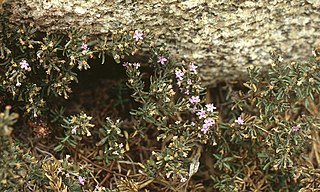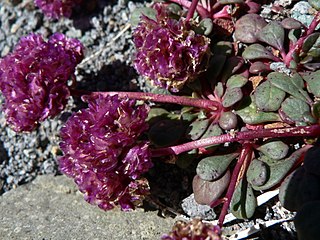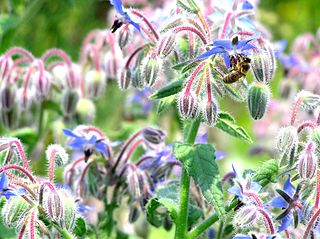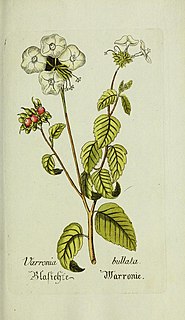
Dichondra is a small genus of flowering plants in the morning glory family, Convolvulaceae. They are prostrate, perennial, herbaceous plants, with creeping stems which take root readily at the leaf nodes. The flowers are white, greenish or yellowish, 2–3 mm diameter. Members of the genus are commonly known as ponysfoots and are native to tropical and cool temperate regions around the world.

Claytonia is a genus of flowering plants native to North America, Central America, and Asia. The genus was formerly included in Portulacaceae but is now classified in the family Montiaceae, primarily native to the mountain chains of Asia and North America, with a couple of species extending south to Guatemala in Central America, and northwest to Kazakhstan, Mongolia, and Russia in eastern Asia.

Colubrina is a genus of about 30 species of flowering plants in the family Rhamnaceae, native to warm temperate to tropical regions of Africa, the Americas, southern Asia, northern Australia, and the Indian Ocean islands. Common names include nakedwood, snakewood, greenheart and hogplum. The generic name is derived from the Latin word coluber, meaning "snake", and refers to the snake-like stems or stamens.

Frankenia salina, often called alkali heath or alkali seaheath, is a perennial herb native to California, Nevada, Mexico and Chile. It is uncommon even in the region where it is most likely to be found, just north of the San Francisco Bay Area.

Cistanthe is a plant genus which includes most plants known as pussypaws. These are small, succulent flowering plants which often bear brightly colored flowers, though they vary quite a bit between species in appearance. Some species have flowers that are tightly packed into fluffy-looking inflorescences, the trait that gives them their common name. Many are adapted to arid environments, with some able to withstand climates that almost completely lack rainfall. Cistanthe was a genus created to segregate several species previously classified in Calandrinia. Several species from other closely related genera have been moved into Cistanthe as well.
Euplassa is a genus of flowering plants in the protea family.

Boraginoideae is a subfamily of the flowering plant family Boraginaceae s.s, with about 42 genera. That family is defined in a much broader sense in the Angiosperm Phylogeny Group (APG) system of classification for flowering plants. The APG has not specified any subfamilial structure within Boraginaceae s.l.

Ehretia is a genus of flowering plants in the borage family, Boraginaceae. It contains about 50 species. The generic name honors German botanical illustrator Georg Dionysius Ehret (1708–1770).
Errazurizia (dunebroom) is a genus of flowering plants in the legume family, Fabaceae. It belongs to the subfamily Faboideae.

Distichlis is a genus of American and Australian plants in the grass family. Plants in this genus are dioecious, have rhizomes or stolons, and have conspicuously distichous leaves.

Stillingia texana, the Texas toothleaf, is a species of flowering plant in the family Euphorbiaceae. It is native to the South Central United States and Mexico. In central Texas it is widespread in upland, calcareous prairies, spreading north to scattered locations in Oklahoma and south to Coahuila. Stillingia texana was described in 1923 by Ivan Murray Johnston.

Stillingia treculiana, Trecul's toothleaf, is a species of flowering plant in the family Euphorbiaceae. It was originally described as Gymnanthes treculianaMüll.Arg. in 1865. It is native to southern Texas in the United States and northeast Mexico, growing in sandy and gravelly soils in dry habitats.

Varronia is a genus of flowering plants in the family Boraginaceae, found throughout Latin America, the Caribbean, and in the US states of Texas and Florida. They were resurrected from Cordia in 2007.
Viscainoa is a genus of flowering plants belonging to the family Zygophyllaceae.

Trigonotis is a genus of flowering plants belonging to the family Boraginaceae.
Amblynotus is a genus of flowering plants belonging to the family Boraginaceae.
Thaumatocaryon is a genus of flowering plants belonging to the family Boraginaceae.
Antiphytum, commonly known as saucerflower, is a genus of flowering plants belonging to the family Boraginaceae.
Dasynotus is a genus of flowering plants belonging to the family Boraginaceae.










